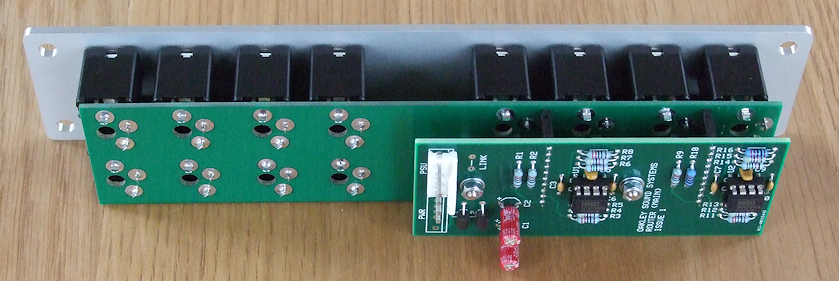
Constructional difficulty: Easy

The Oakley Router is a simple but useful module. The top section is two passive multiples. A multiple, or 'mult', is a number of sockets, in this case four, that are connected together in parallel. It can be used to send one output to up to three other destinations, splitting the input signal into three. This is useful for sending, for example, the gate output of a midi-CV convertor, to three envelope generators so that all three envelopes trigger together. Or a single sawtooth output from one VCO to two filters for parallel processing.
The lower section contains four identical inverting amplifier circuits. The amplification can be set when building the unit but the suggested gains are either -1, -0.33, or -0.1*. Each output is balanced and uses a 1/4” TRS (tip ring sleeve) socket which can be connected directly, using a balanced cable, to a balanced input of an audio interface or mixing desk without introducing ground loops. The outputs can, however, also be used with unbalanced inputs, and the outputs will not be damaged if you use standard mono unbalanced (TS) cables.
Each of the output amplifiers are inverting, that is a positive going signal is turned into a negative going signal. This has no audible effect on the audio signal but will change the polarity of any control voltages passed through it. The module could thus be used as an effective quad inverter if required.
* Some audio interfaces and most guitar effects pedals distort with the high signal levels coming from a modular synthesiser so reducing the signal level can aid interfacing troubles. For audio interfaces that have such problems I recommend the gain be set to -10dB which is a voltage gain of 0.33. For guitar pedals it is best to reduce it to a tenth of the original signal which is voltage gain of 0.1. Each of the four output stages can have a different gain if required.
The module is built from two printed circuit boards (PCBs), the larger socket board and the smaller four layer main board. Both boards are required to build the project and are sold as a set.
The module accommodates either our standard Oakley/MOTM power header or a Synthesizers.com power header. Current consumption is +/-16mA at +/-15V.

This shows the module built behind a 1U wide natural finish Schaeffer panel. The two boards are connected together via two 10-way SIL headers and sockets.
Prices
Click here for how to order.
Router issue 1 PCB set ................................................... 18GBP
All other parts can be purchased from you usual electronic component supplier.
Shipping is additional to this price. See also the FAQ page.
Project Downloads
Construction Guide Our handy guide to building Oakley DIY projects
Parts Guide Our handy guide to buying parts for Oakley DIY projects.
Schematics are available to purchasers of the PCBs and will only be sent via e-mail when the board(s) are shipped.
Front Panel database
A Schaeffer front panel can be made for this module. The databases can be found by downloading the following links:
5U format 1U wide Router module in traditional black
5U format 1U wide Router module in natural (silver) finish
To read these files you will need a copy of 'Frontplatten designer' from Schaeffer. The company are based in Berlin in Germany and will send out panels to anywhere in the world. Delivery to the UK normally takes around ten working days. For North American users you can also order your Schaeffer panels from Front Panel Express.
Back to projects page: Projects
Back home